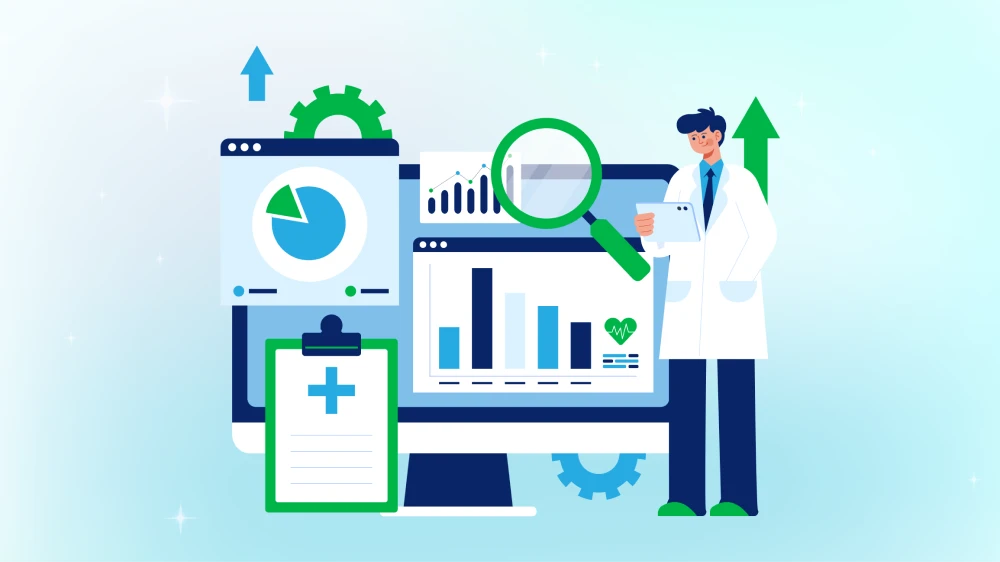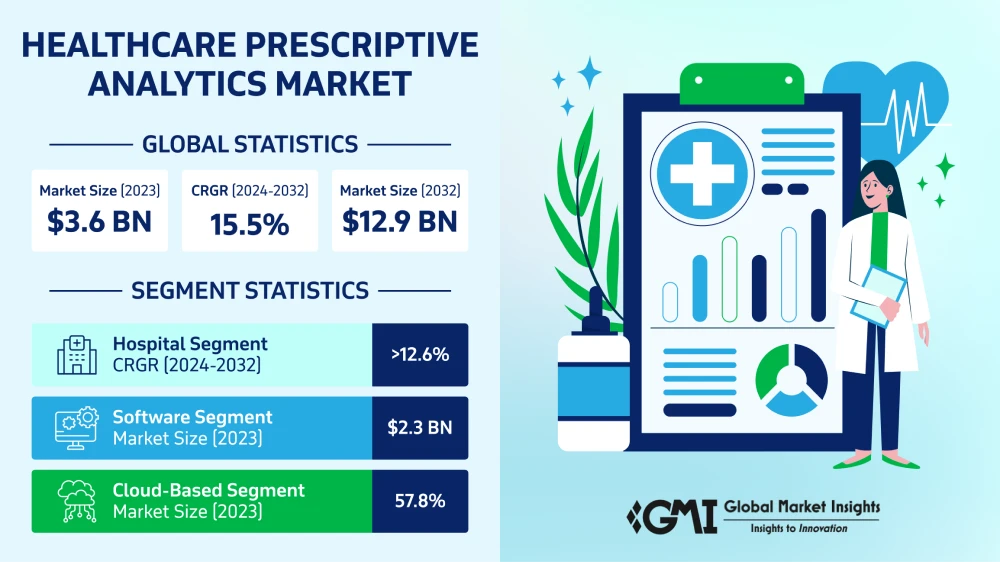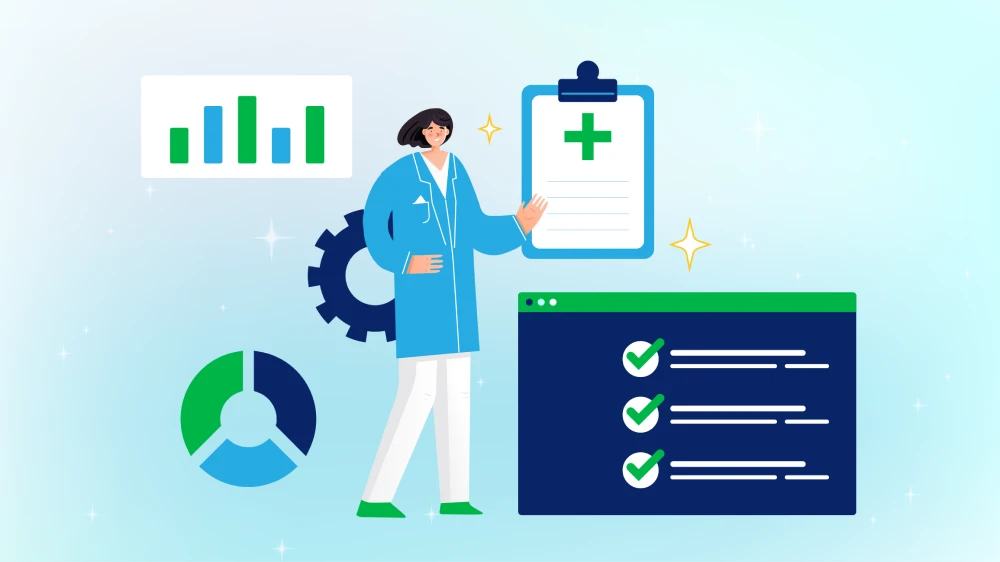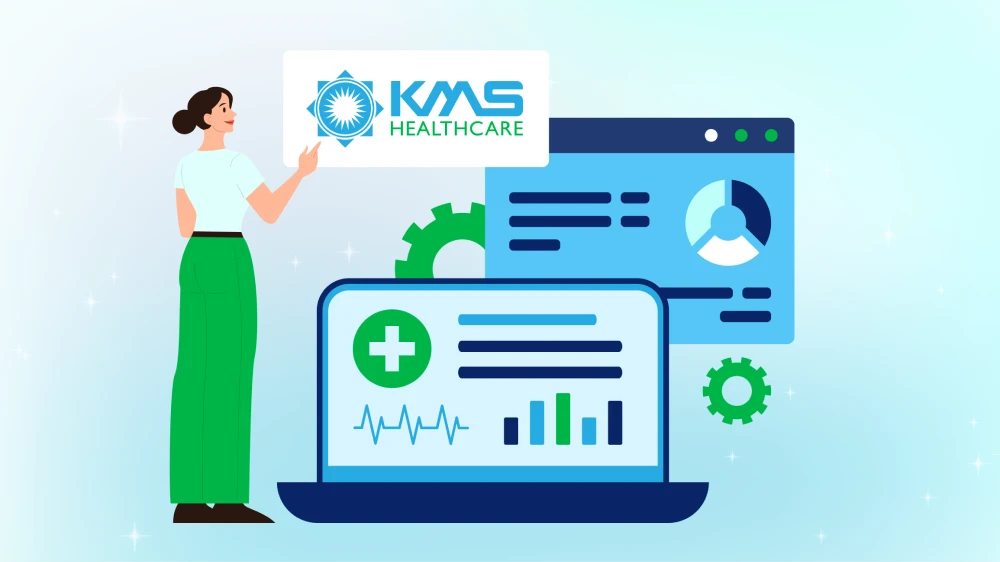As healthcare organizations adopt data-driven care, the challenge isn’t just collecting data—it’s knowing what to do with it. Healthcare organizations need advanced analytics to predict what will happen and provide actionable paths forward.
Healthcare predictive analytics forecasts future trends, but prescriptive analytics in healthcare takes it further and provides actionable solutions. Prescriptive analytics offers businesses a roadmap to better results, whether in patient care, operational efficiency, or financial performance.
Let’s examine how adopting prescriptive analytics in healthcare helps you stay ahead of the competition.
What is Prescriptive Analytics in Healthcare?
Prescriptive analytics in healthcare is an advanced data-driven approach that does more than ID trends or predict future events. It uses complex models and machine learning algorithms to analyze multiple data sources and determine the best action based on specific outcomes.

Prescriptive analytics evaluates different scenarios, weighs potential outcomes, and recommends the most effective strategy based on their models. Models that answer critical questions.
- Which treatment plan will deliver the best results for a patient?
- How can we optimize our resources to improve efficiency?
- What type of strategy should we use to enhance care access?
This analytical approach turns predictions into actionable insights, allowing healthcare organizations to test different hypothesized scenarios using a proactive approach to healthcare management.
Why Healthcare Needs Prescriptive Analytics
According to Global Market Insight, the market for healthcare prescriptive analytics is growing significantly, and here are three reasons why:

1. Informed Clinical Decision-Making
Prescriptive analytics provides more than just a snapshot of potential risks or outcomes. It equips healthcare teams with actionable insights to address issues before they escalate.
While predictive analytics might flag a case of increased risk of hospital-acquired infections, prescriptive analytics takes it further by identifying the source of the problem—such as a specific protocol breach—and recommending steps to prevent it from spreading. This allows for more proactive care and better clinical outcomes.
2. Proactive Patient Care
Prescriptive analytics equips healthcare providers with the tools to move from reactive to proactive care. These tools help link clinical priorities and measurable events, such as clinical protocols or cost-effectiveness to provide the most effective solutions.
For instance, predictive analytics might identify a patient likely to be readmitted within a month. Prescriptive analytics can recommend actionable steps—adjusting follow-up care, managing medications, or reconfiguring staffing to ensure adequate care during the patient’s high-risk period. Prescriptive analytics reduces readmission rates and enhances the patient experience by empowering healthcare teams to make timely, well-informed decisions.
3. Sound Financial Decisions
Beyond clinical applications, prescriptive analytics can lower operational costs across the board. It provides insights that help healthcare organizations optimize everything from department budgets to patient billing, driving short-term efficiencies and long-term financial health.
Organizations can streamline operations and reduce unnecessary spending while maintaining high-quality care by making smarter, data-driven decisions.
Overcoming Common Challenges in Prescriptive Analytics
While prescriptive analytics offers immense potential in healthcare, it’s not without its challenges. Here are some of the key challenges of the prescriptive analytic healthcare industry you will need to consider:

1. Human bias in models
One of the most significant challenges in prescriptive analytics is the potential for human bias in the models. Since many models are built with input from domain experts, their opinions can influence the algorithms. This bias can skew results, leading to less accurate or even harmful recommendations.
Solution: Shift toward machine learning models that are data-driven, not opinion-driven. By allowing algorithms to adjust based on real-time data, organizations can reduce bias and generate more reliable outcomes that are truly reflective of the data.
2. Difficult to define a fitness function
Every prescriptive model needs a well-defined fitness function to optimize decisions—a measure of how well a solution meets the desired outcomes. However, creating this function requires a deep understanding of the business goals, clinical priorities, and operational constraints.
Solution: Close collaboration between technical teams and business leaders is needed to overcome this challenge. By involving key stakeholders early on, organizations can ensure that the fitness function aligns with both clinical outcomes and business objectives, making the model more effective.
3. Complex constraints
Prescriptive analytics often operates within a web of constraints—business rules, clinical guidelines, regulatory requirements, and physical limitations. These constraints can make it difficult for models to find feasible solutions. For example, certain recommendations may be technically accurate but impossible to implement due to resource limitations or policy restrictions.
Solution: Organizations need to build flexibility into their models to overcome this. By incorporating these constraints directly into the algorithms or the fitness function, the models can provide actionable solutions that are both practical and compliant.
Best practices to empower prescriptive analytics
Implementing prescriptive analytics in healthcare requires more than just powerful algorithms; it demands a thoughtful approach to ensure that the insights generated can drive real, impactful change. Here are three best practices that can help healthcare organizations maximize the value of prescriptive analytics:

1. Prioritize Built-in Capabilities
Data is growing exponentially in healthcare, and the need for real-time decision-making is becoming more urgent. Use automation to enable faster processing and decision-making without manual intervention.
By investing in applications with built-in capabilities, healthcare providers can streamline analytics processes and save decision-makers valuable time. This allows doctors, nurses, and other healthcare professionals to focus more on patient care while the technology handles the heavy lifting of data analysis.
2. Build a Strong Data Foundation
The power of prescriptive analytics lies in the data it analyzes. Even the most advanced models will fall short without a solid data foundation. Healthcare organizations must focus on building a connected, comprehensive data ecosystem where patient information, clinical protocols, and operational metrics are seamlessly integrated.
A robust data foundation enhances the effectiveness of prescriptive analytics and positions your organization to respond more quickly to emerging healthcare challenges. Using actionable insights, healthcare providers can better time interventions and make more accurate treatment recommendations.
3. Consult expert guidance
Even with advanced analytics tools in place, human expertise is still essential for success. Prescriptive analytics models generate insights, but it takes experienced professionals to translate them into actionable strategies. Collaborating with trusted, experienced partners ensures that healthcare organizations can fully leverage the potential of prescriptive analytics.
Establish a clear plan for implementing these insights and assign the right people to guide the process. Prepare staff for any changes in roles or responsibilities that may arise as a result of adopting prescriptive analytics.
Make Confident Data Decisions with KMS Healthcare
As healthcare data continues to grow, leveraging advanced analytics is essential for staying competitive and improving outcomes. Successful organizations will be those that can use prescriptive analytics to understand patients, providers, and stakeholders better.

At KMS Healthcare, we specialize in helping healthcare organizations implement advanced analytics solutions that turn data into actionable insights. Our team of experts will work with you to build innovative, integrated systems that are customized to your data needs:
- Experience with Healthcare: Unlock the potential of your data with our platform-certified team of healthcare data analytics experts.
- Optimize Clinical and Financial Decisions: We use data-backed recommendations to help you drive tangible business results.
- Scalable Solutions: Our analytics solutions grow with you, ensuring long-term success as your healthcare organization evolves.
You can confidently navigate the complexities of healthcare analytics with us in your corner. Reach out to explore our BI and data analytics services today.
